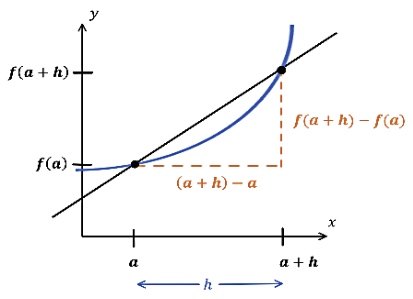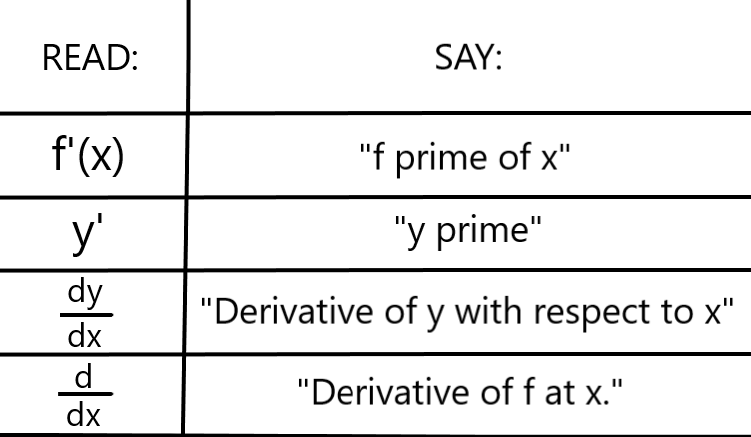These are my complete notes for Derivatives in Differential Calculus.
I color-coded my notes according to their meaning - for a complete reference for each type of note, see here (also available in the sidebar). All of the knowledge present in these notes has been filtered through my personal explanations for them, the result of my attempts to understand and study them from my classes and online courses. In the unlikely event there are any egregious errors, contact me at jdlacabe@gmail.com.
Summary of Derivatives (Differential Calculus)
?. Derivatives.
#
Rule .
A secant line is a line that intersects the line at two places. The slope of the secant line is the average rate of change between the two points.
#
Rule .
A tangent line is a line that intersects a curve at exactly one point. The slope of the tangent line is the instantaneous rate of change at a point.
# Difference Quotient: $$\frac{f(x + h) - f(x)}{h}$$ The "Difference Quotient", given above, represents the secant line of a curve from the point (a, f(a)) to (a+h, f(a+h)), which is also the average rate of change from x=a to x=a+h:
The graph of a curve f, which has a secant line from (a, f(a)) to (a+h, f(a+h)), which is given by the difference quotient. Courtesy of Study.com.
# Normal Line: The line normal to a curve is the line perpendicular to the tangent at that point.
#
Rule .
When the limit exists, it's called the derivative of f at a, or any point. The derivative is f'(x) =
$$\lim_{h \to 0} \frac{f(x + h) - f(x)}{h}$$
provided the limit exists. "Differentiate" means to determine the Derivative.
# Verbal Descriptions of Calculus Notation:
A "READ:", "SAY:" chart for f'(x), y', dy/dx, and d/dx.
#
Rule .
Graphing the derivative without knowledge of the formulas for dy/dx nor the parent function, is wack:
First, get the slope between two points on the original f(x) and find the slope. As x increases, a decreasing f(x) value indicates a negative slope, while an increasing f(x) value indicates a positive slope. Find an x-value in the middle of the two points and use it as the x-value. Use the slope as the y-value and plug into the new graph, and repeat. Fo a graph with "pointy points", known as corners, they are undefined in the derivative graph (the f'(x)), as they do not have local linearity (see [[[).
First, get the slope between two points on the original f(x) and find the slope. As x increases, a decreasing f(x) value indicates a negative slope, while an increasing f(x) value indicates a positive slope. Find an x-value in the middle of the two points and use it as the x-value. Use the slope as the y-value and plug into the new graph, and repeat. Fo a graph with "pointy points", known as corners, they are undefined in the derivative graph (the f'(x)), as they do not have local linearity (see [[[).
#
Rule .
When a fraction has a square root, standard procedure is to multiply it by a conjugate, especially if the square root is on the denominator.
#
Rule .
For the alternate definition of the derivative, you always want to do all the algebra first before substituting for a at the end. Then, you can do a.
#
Rule .
Function f(x) is differentiable on a closed interval [a, b] if it has a derivative at every interior point of the interval, and if the limits below exist at the endpoints.
$$\lim_{h \to 0^+} \frac{f(a + h) - f(a)}{h}$$ is the right-hand derivative, and
$$\lim_{h \to 0^-} \frac{f(b + h) - f(b)}{h}$$ is the left-hand derivative.
$$\lim_{h \to 0^+} \frac{f(a + h) - f(a)}{h}$$ is the right-hand derivative, and
$$\lim_{h \to 0^-} \frac{f(b + h) - f(b)}{h}$$ is the left-hand derivative.
#
Rule .
The left hand derivative can be found by using the regular f(x), while the right hand derivative is found by using the equation of the f'(x) derivative found from the left hand derivative. If the two derivatives are equal to each other, then the derivative in totality is real.
# Differentiability: The ability to find slope at a point, which is necessary to take the derivative.
# Cases when f'(a) doesn't exist (or, when a point is non-differentiable):
- A Corner: f(x) = |x|
A corner occurs when, at the point a, the function on the graph will make a sharp turn, and its slope will change instantaneously.
- A Cusp: f(x) = x2/3
A cusp occurs when the line gradually curves into a sharp corner. In effect, the cusp is a special case of the corner: the cusp only has one possible tangent, while a corner has two distinct ones.
- A Vertical Tangent: f(x) = ∛x
When the line is vertical, there is no slope, and thus it is non-differentiable at that point.
- A Discontinuity:
For example, a non-continuous piecewise function. The derivative (nor the limit, if it is a jump discontinuity) exists at a point that is discontinous.
# Local Linearity: If you focus on a point on a curve, if you continuously zoom in on the point, eventually the graph of the curve at the point will resemble a line. Differentiability implies local linearity.
#
Rule .
The symmetric difference quotient is as follows:
$$f'(x) = \lim_{h \to 0} \frac{f(x + h) - f(x - h)}{2h}$$
It is used any time you want the derivative from each side of the tangent line (the distance being h), rather than from just one side.
#
Rule .
A derivative is a limit. Not only does the limit have to exist, it must also be continuous. The slope on the left being different from the derivative on the right rules out corners from having derivatives. If the slope becomes a vertical line (e.g., slope/m = infinity), then the derivative also does not exist.
# General Rules of Derivatives:
- Constant Rule: (d/dx) c = 0
- Power Rule: (d/dx) xn = nxn-1
- Trigonometric Rules: (d/dx) sin(x) = cos(x)
(d/dx) cos(x) = -sin(x) - Exponential Rule: (d/dx) bx = bx × ln(b)
- Logarithmic Rule: (d/dx) ln(x) = 1/x
#
Rule .
For a derivative to be, it must have local linearity. No matter how much you zoom into a corner or cusp, they will never have local linearity, and this is why they are considered "non-differentiable" entities.
#
Rule .
When taking the derivative at zero of any function f(x) = xeven/odd, for any matching exponent value, it will never exist. xeven/odd will always produce a corner or cusp at x=0, and thus cannot have a derivative at that point.
# Theorem of Differentiability: Differentiability implies continuity. However, continuity does not imply differentiability. If f has a derivative at x = a, then f is continuous at x = a.
# Intermediate Value Theorem (for Derivatives): If a and b are any two points in an interval on which f is differentiable, the f' takes on every value between f'(a) and f'(b).
#
Rule .
Laws of Differentiation
As used below, all functions f(x), g(x), and h(x), are differentiable functions, and n & c are constants.
As used below, all functions f(x), g(x), and h(x), are differentiable functions, and n & c are constants.
- Law 1: Derivative of a Constant.
f(x) = c
c ∈ ℝ
f'(x) = 0.
Examples: f(x) = 5, f'(x) = 0, slope is 0.
- Law 2: Power Rule.
f(x) = xn
f'(x) = n × xn-1
Examples: f(x) = x², f'(x) = 2x.
- Law 3: Constant Multiple Rule.
f(x) = c × h(x)
f'(x) = c × h'(x)
Examples: f'(x) = 2x³, f'(x) = 2[(x³)'], f'(x) = 6x²
f(x) = 4x⁶ + 2x10, f'(x) = 24x⁵ + 20x⁹
- Law 4: Sum and Difference Rule.
(f(x) ± g(x))' = f'(x) ± g'(x)
Examples: f(x) = 2x + x², f'(x) = 2 + 2x
#
Rule .
In order to find the horizontal tangents of a curve, you must find the derivative and then make it equal to 0, and then factor as you see fit.
# Product Rule:
(f × g)' = f'g + fg'
# Quotient Rule:
(f / g)' = (f'g - fg') / (g²)
# Higher Order Derivatives:
- y' = (dy / dx) is the first derivative of y with respect to x.
- y'' = (d²y / dx²) is the second derivative of y - double prime.
- y''' = (d³y / dx³) is the third derivative of y - triple prime.
- y(n) = (dny / dxn) is the nth derivative of y - nth prime.
#
Rule .
Derivatives are allowed to be plugged in over addition and subtraction operations, such as (d/dx)(7v - 3u), requiring the substitution of the derivatives of v and u into the equation.
#
Rule .
The derivative is the slope (rate of change) at any given point on a curve: If you are given a graph of x and asked to find the graph of the "rate of change", just find the derivative graph: The values to be plugged into the Product or Quotient rules are already given!





